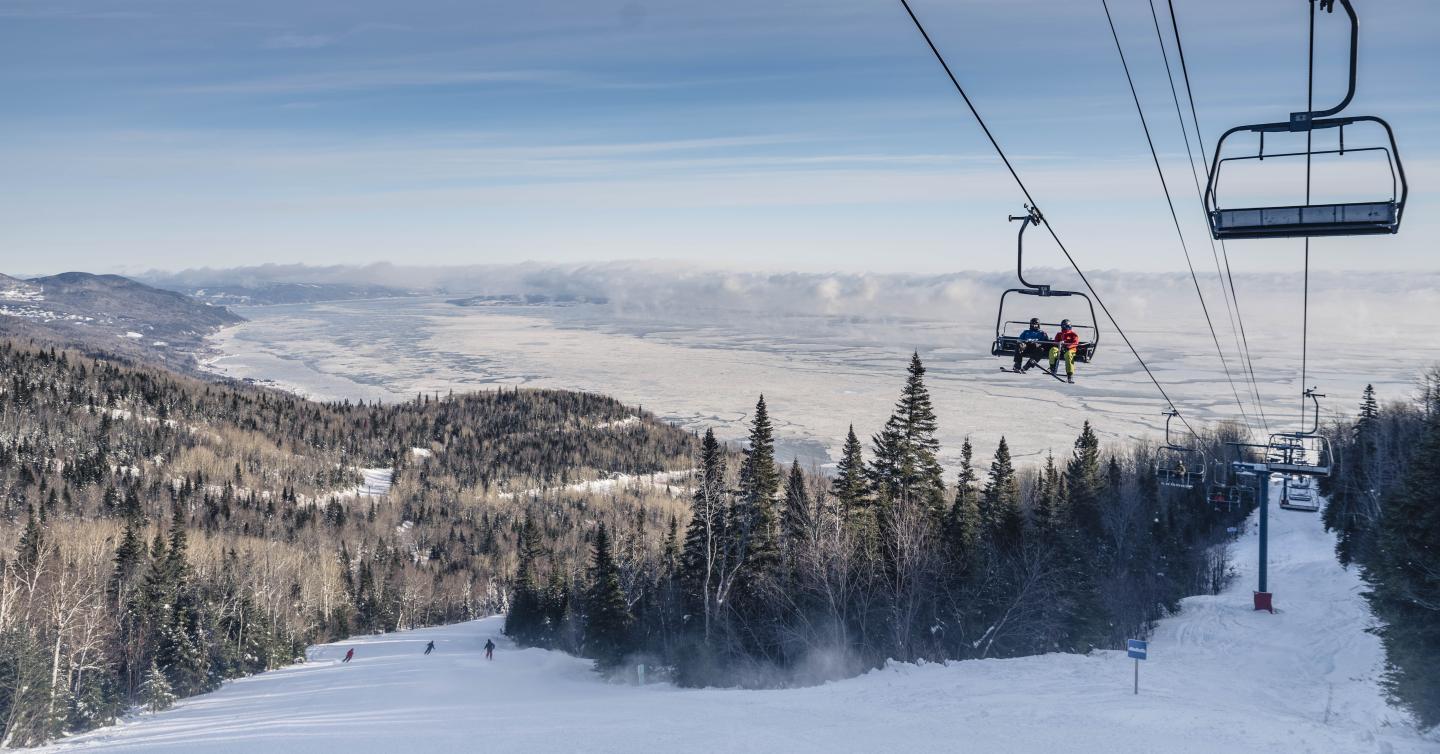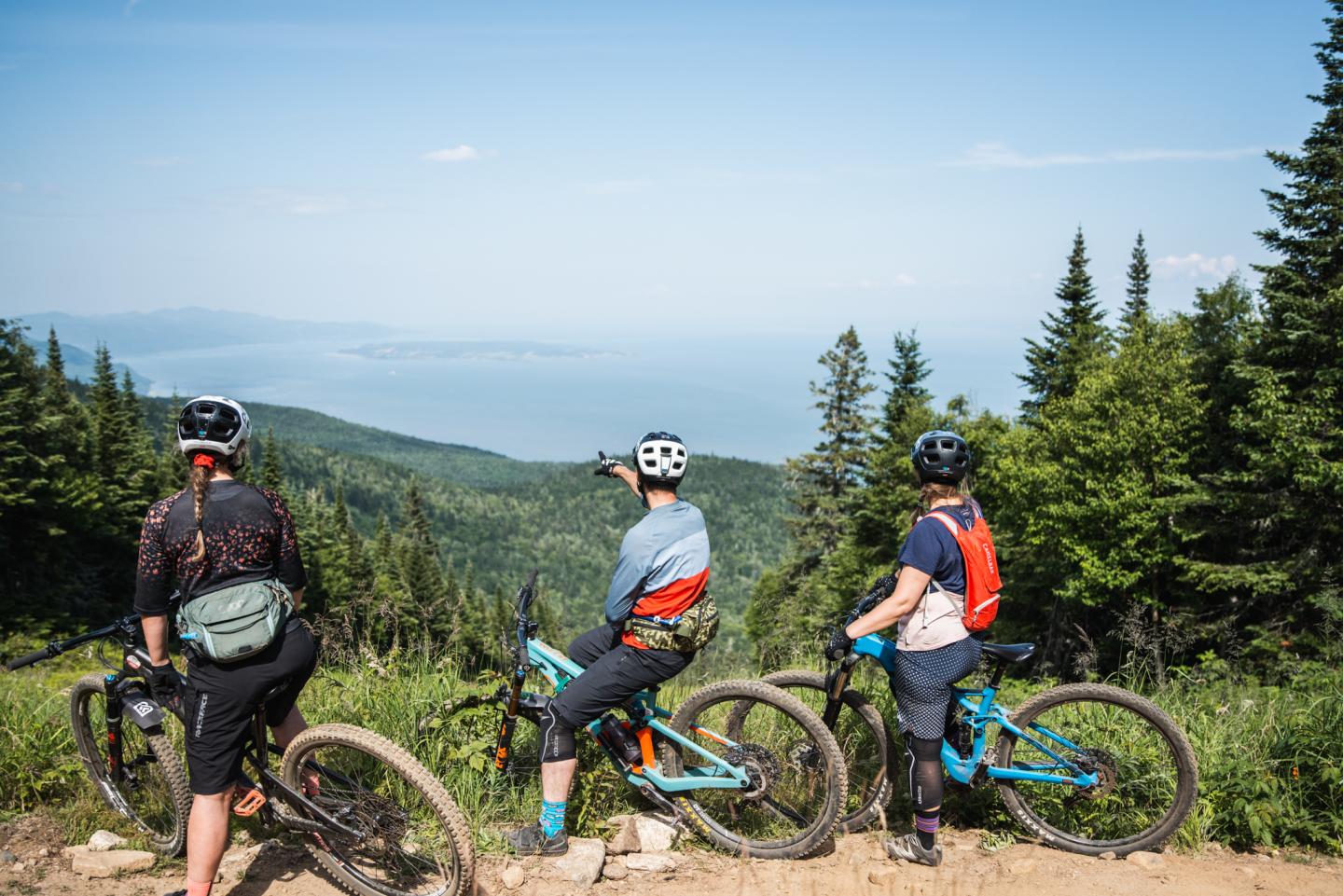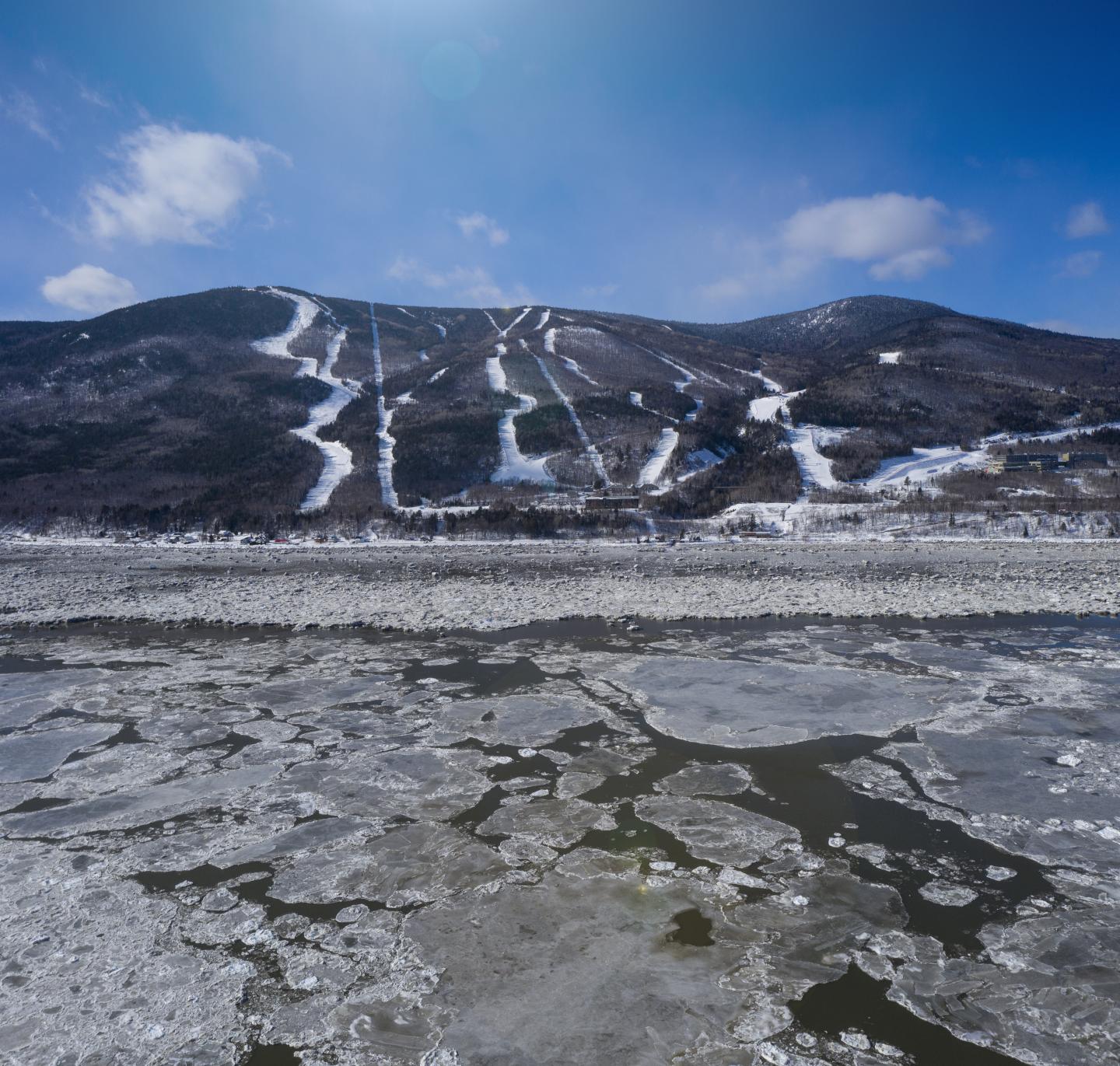
Looking for breathtaking landscapes in Quebec? One of the places with the most breathtaking scenery is Le Massif de Charlevoix. Less than 100 km from Quebec City, Le Massif offers some of the best views in the province, whatever the season.
But it's not the only place that offers a unique visual experience. That's why we've selected 10 must-see places that will make you fall in love with Quebec's natural beauty.

1. Le Massif de Charlevoix
Located in Petite-Rivière-Saint-François, just under an hour from Quebec City, Le Massif de Charlevoix is a ski resort in Quebec like no other. Overlooking the St. Lawrence River, it offers the highest vertical drop east of the Canadian Rockies (770 metres). What truly sets Le Massif apart is its breathtaking landscape: skiing down the slopes with the endless river view in front of you is amazing.

The ski area has over 50 runs for all levels, from beginner to intermediate and advanced. The snow cover is generous, approaching 6 meters per season, making it a popular destination for powder lovers.
Some of the mountain's breathtaking vantage points: the Buton lookout, offering a breathtaking 360-degree view of the river and the entire territory; the Camp Boule mountain restaurant, where you can dine, enjoy an aperitif or dine in winter while taking in incomparable river panoramas.
When to go?
The ski season usually runs from early December to mid-April, depending on snow conditions. January and February are ideal for fresh powder and high-quality skiing, though they’re also the coldest months. For milder temperatures and fewer crowds, March often provides the best days, comfortable skiing with plenty of sunshine.
Le Massif is also worth a visit in summer and fall, offering year-round activities like hiking, mountain biking, gondola rides, and canyoning, all with the river as a stunning backdrop.
Lodging at Le Massif
Le Massif offers several lodging options at the trail entrance or exit. Accommodations include modern chalets, rental condos, refuges and condos. These are located on the mountain, with ski-in/ski-out access.
2. Vauréal Falls on Anticosti Island (Côte-Nord)
Tucked away in the heart of Anticosti National Park in the Côte-Nord region, Vauréal Falls is without question one of Quebec’s most awe-inspiring natural wonders. This 76-metre-high waterfall plunges into a dramatic 90-metre-deep canyon carved by the Vauréal River.
Visitors can access the site via the Trans-Anticosti road, and two viewpoints are available: an elevated lookout for a sweeping view from above, and a hiking trail that takes you to the base of the falls, for the more adventurous.
Surrounded by raw, untouched nature, Vauréal Falls perfectly captures the wild and unique character of Anticosti Island, a UNESCO World Heritage Site. Whether you’re into photography, wildlife watching, hiking, or simply soaking in the wonder, this destination is well worth the journey.
When to go?
The best time to visit Vauréal Falls is from late June to late August, during the summer season when the park’s facilities are open to the public. Since access to the island is seasonal (by plane or boat), it’s essential to plan your transportation and lodging in advance.
Summer not only offers ideal weather but also the best conditions for hiking, sightseeing, and exploring the park. Outside of this period, access becomes very limited, or even impossible, due to weather and the island’s remote location.
It’s strongly recommended to visit in the summer months when Sépaq services are operational and nature is at its peak.
3. Saguenay Fjord National Park
Saguenay Fjord National Park is one of Quebec’s true natural gems. The park stretches nearly 100 kilometres along the banks of the majestic Saguenay Fjord.
Managed by Sépaq, the park protects a unique environment in North America: a deep, ancient fjord carved by glaciers, bordered by dramatic cliffs that rise over 300 metres high.
With stunning hiking trails, breathtaking viewpoints, sea kayaking excursions, and opportunities to spot seals, birds of prey, and even belugas, the park offers full immersion in a wild and awe-inspiring landscape.
The park is divided into several sectors: Baie-Éternité, Anse-Saint-Jean, Baie-Sainte-Marguerite, and Tadoussac, each offering its own adventure, from active outdoor adventures to peaceful scenic retreats.
When to go?
The park is open year-round, but the best time to fully enjoy it is from late spring to fall (May to October). Summer is ideal for hiking, water activities, and staying in nature. It’s also when the most services are available (shuttles, guided tours, rentals).
In the fall, the changing leaves turn the fjord’s cliffs into a vibrant natural spectacle, an exceptional time for hikers and photographers.
Although quieter in winter, the park remains open and offers snowshoeing and cross-country skiing in select areas. However, many trails and services are closed outside of the summer season, so it’s important to plan accordingly.
4. Cap Bon-Ami – Forillon National Park, Gaspésie
Perched atop towering cliffs plunging into the Gulf of St. Lawrence, Cap Bon-Ami is one of the most iconic viewpoints in Forillon National Park. Easily accessible by car, this site features a stunning lookout where you can admire the sea, weathered limestone cliffs, and, if you’re lucky, whales off in the distance. It’s a prime location for spotting marine and bird life: seals, gannets, eiders, and occasionally minke whales. A wooden staircase leads down to a peaceful, pebbled beach scattered with starfish and gulls.
When to go?
The best time to visit Cap Bon-Ami is between mid-June and late September, when park facilities are open and the weather is usually more pleasant. In summer, the golden light of sunrise or sunset turns the cliffs into a spectacular natural show, perfect for photographers and landscape lovers. Wildlife watchers may prefer July and August, when whale sightings are more frequent. Keep in mind the site is exposed and lacks shade, so it’s best to visit on clear, calm days and avoid strong winds or fog.
5. Brion Trail – Kegaska, Côte-Nord
At the eastern end of Route 138, in the small coastal village of Kegaska, you’ll find a place as surprising as it is rich in history: the Brion Trail. This short, linear trail (about 1 km round-trip) leads directly to a striking shipwreck, the Brion, a vessel from the Magdalen Islands that has rested here since 1976.
Following a wooden boardwalk across coastal tundra, visitors reach a windswept, rocky point where the rusting remains of the ship sit dramatically against the crashing waves. It’s a hauntingly beautiful landscape, ideal for photography enthusiasts or lovers of remote, open spaces.
When to go?
The Brion Trail is accessible year-round, but summer—between June and September—is by far the most comfortable time to visit. With mild weather, long daylight hours, and dry trails, it’s the ideal season for exploring, especially if you’re travelling from afar. Sunsets over the wreck are particularly unforgettable. Fall, from late September to early October, brings golden hues and a tranquil atmosphere, though cooler temperatures and breezy conditions may set in.
6. Jacques-Cartier Valley, Quebec Region
Located just about 30 minutes from downtown Quebec City, the Jacques-Cartier Valley is a natural gem and an iconic feature of the region. Carved by glaciers thousands of years ago, this deep valley impresses with its steep cliffs, dense forests, and winding river that flows through the heart of the vast mountainous corridor. At its core lies Jacques-Cartier National Park, a protected area of more than 670 km² managed by Sépaq.
When to go?
Jacques-Cartier Valley is a destination worth exploring year-round, with each season offering a unique experience. Summer (June to August) is the most popular time, perfect for hiking, water sports like canoeing and tubing, and camping—though you can expect crowds, especially on weekends. Fall (September to October) transforms the valley into a stunning display of fiery maple colours, creating a quieter, cooler atmosphere ideal for photographers and peaceful hikes. In winter (December to March), the park turns into a snowy playground with trails for snowshoeing, cross-country skiing, and fat biking—perfect for those who embrace an active winter. Ultimately, the best time to visit depends on your preferences, your tolerance for cold, and how well you handle mosquitoes!
7. Mont Chaudron Valley (Abitibi‑Témiscamingue Region)
Mont Chaudron, also known as Mont Cheminis, is a notable peak located in the Arntfield area, west of Rouyn-Noranda, in the Abitibi-Témiscamingue region. Standing alone in the landscape, this 527-metre summit towers above the surrounding area, offering sweeping views of the boreal forests, lakes, and rolling hills. Its unique shape, reminiscent of an inverted cauldron, gives it its name and makes it a distinctive visual landmark in the Abitibi region.
When to go?
The best time to visit Mont Chaudron is from late May to mid-October, when the trails are dry and hiking conditions are optimal. Summer and early fall are especially popular: there are fewer springtime mosquitoes, and the weather is pleasant. In autumn, the vivid colours of the boreal forest add a spectacular touch to the landscape.
8. La Grande River – Eeyou Istchee Baie‑James
Located in northern Quebec, the La Grande River is an impressive waterway that stretches nearly 900 km through the Eeyou Istchee Baie‑James region before flowing into James Bay. Its Cree name, Chisasibi, means “great river,” aptly describing its power, breadth, and historic significance.
It’s best known as the backbone of Hydro-Quebec’s La Grande hydroelectric complex, one of the largest in the world. Several dams, including La Grande‑1 near the Cree village of Chisasibi, regulate its flow and create massive reservoirs. Despite these transformations, the area retains a stunning boreal landscape dotted with forests, powerful rapids, wetlands, and endless lakes.
When to go?
The best time to visit the La Grande River region depends on what kind of landscape you’re after. Summer (June to August) offers the most accessible conditions, with long days, mild weather, and easier road access—ideal for hiking, wildlife watching, and exploring the northern wilderness or attending local Cree cultural events.
In September, the boreal forest comes alive with vibrant fall colours, creating a quieter, more introspective atmosphere that’s perfect for solitude seekers and photographers—though, let’s be honest, this region is remote any time of year.
Winter (November to March) is for the truly adventurous: snow-covered landscapes, clear skies for northern lights viewing, and a raw, untamed beauty—but with temperatures often plunging below ‑30 °C, good preparation is essential. While each season offers its own perspective on this vast and deeply alive land, summer remains the most practical time to visit.
9. Percé Rock, Gaspésie
A defining symbol of Gaspésie, Percé Rock is a striking natural formation located just off the village of Percé in the Gulf of St. Lawrence. Over 400 metres long and nearly 90 metres high, this massive limestone monolith, pierced by a natural arch, attracts hundreds of thousands of visitors each year who come to admire its majestic silhouette.
Designated a protected site and part of the Bonaventure Island and Percé Rock National Park, it’s also recognized as a UNESCO Global Geopark. This status highlights not only its exceptional geological importance but also its key role in the cultural and touristic identity of the region.
When to go?
The best time to visit Percé Rock is from late May to mid-October, when tourism services are fully operational. During this period, boat cruises around the rock and excursions to Bonaventure Island, home to the largest colony of northern gannets in North America, are offered daily. In summer, the village of Percé comes alive with festivals, street performances, art galleries, and local goods to explore. September brings a quieter vibe and stunning fall colours, perfect for hiking.
10. Manitou Falls, Côte-Nord
Located between Rivière-au-Tonnerre and Sept-Îles, Manitou Falls is one of Côte-Nord’s hidden treasures. Standing 35 metres tall, it offers a breathtaking natural display as the Manitou River tumbles down in a classic boreal setting. Easily accessible from Route 138 at kilometre 1088, the site includes a parking area, a welcome centre, and marked trails. A short forest walk leads to several viewpoints, including a platform near the base of the falls, accessible via secure stairs.
When to go?
The best time to visit Manitou Falls is between late May and mid-September. During this period, trails are clear, facilities are open, and the river’s flow is at its strongest in early spring. In summer, the falls remain impressive, though with a gentler flow—creating a serene and relaxing atmosphere. Autumn adds a spectacular touch with the forest’s vibrant colours, though some services may be reduced.
Why Explore Quebec?
Discover a Wide Range of Scenic Landscapes
Quebec offers a diverse array of natural wonders, ranging from towering mountains to lush forests. In particular, the province boasts stunning national parks such as Gaspésie, which are ideal for outdoor enthusiasts.
Additionally, breathtaking waterfalls are scattered throughout the landscape, offering countless picturesque photo opportunities. Along the Gaspé Peninsula, dramatic coastal cliffs further highlight Quebec’s rugged beauty. Altogether, the region’s varied terrain makes it a true paradise for landscape design aficionados.
Take in the St. Lawrence River and Its Shores
Explore charming waterfront towns like Tadoussac, renowned for its exceptional whale watching opportunities. To further appreciate Quebec's stunning coastline, enjoy scenic boat tours that provide unique perspectives from the water.
Just outside Quebec City, a visit to Île d'Orléans offers a delightful glimpse into rural riverside life, rich in history and local flavours. For a different kind of river, the Thousand Islands region, where the Saint Lawrence River meets Lake Ontario, reveals a captivating mosaic of islands and waterways.
Enjoy the Colours of All Four Seasons
Spring brings vibrant blooms and the return of migratory birds to Quebec, marking the beginning of nature’s renewal. As the seasons progress, summer arrives with warm temperatures that are perfect for outdoor adventures and lively festivals.
In the fall, the landscape turns vibrant with shades of red, orange, and gold — a highlight for anyone who enjoys autumn scenery. In winter, the province offers great conditions for outdoor activities and relaxing stays.
Throughout the year, each season presents its own unique photo opportunities and memorable experiences for visitors.
Feel Quebec's Unique Identity Firsthand
-
Join in the Saint-Jean-Baptiste festivities and feel the pride of Quebec
-
Taste our unique gastronomy in the many local restaurants
-
Visit our heritage sites to discover our rich and fascinating history
-
Interact with locals in small villages to appreciate our warm welcome
-
Attend a French-language comedy show to soak up our sense of self-deprecation
Discover One of Quebec's Most Stunning Landscapes at Le Massif de Charlevoix!
Are you craving an escape to breathtaking landscapes? Look no further than Le Massif de Charlevoix. We offer a four-season playground with activities for every nature lover. From skiing down Canada's highest vertical drop east of the Rockies to hiking trails with spectacular St. Lawrence River views, our resort promises unforgettable views.
Book your adventure today and immerse yourself in Quebec's natural beauty!
Frequently Asked Questions About Québec Landscapes
Where Can I Find the Most Spectacular Views
The breathtaking panoramas of Charlevoix, Saguenay and Gaspésie offer stunning views thanks to their unique geography. The Saguenay fjord, Charlevoix mountains and Gaspesian cliffs will leave you speechless. To capture these moments, get your camera ready with a wide-angle lens and a stable tripod. You'll be able to immortalize Quebec's natural beauty at its best.
How Can I Hike Safely in Quebec?
Your safety when hiking starts with good preparation. Make sure you have the right equipment: walking shoes, appropriate clothing and a backpack containing water and snacks. Evaluate your physical condition and choose a trail that corresponds to your level. Find out about the route and expected weather conditions. Don't forget to tell someone about your itinerary, and take along a first-aid kit.
Can Urban Life and Nature Exploration Go Hand in Hand?
Absolutely! Our cities seamlessly blend metropolitan buzz with natural beauty. Montreal's Mount Royal Park offers lush greenery and panoramic city views just steps from downtown. Quebec City's Plains of Abraham provide a historic urban oasis perfect for picnics or leisurely strolls. Many cultural festivals celebrate our connection to nature, like Montréal en Lumière, which transforms winter nights into magical outdoor experiences. Quick day trips from major centres let you immerse yourself in nature without straying far from urban comforts.
When Is the Best Time to See the Fall Colours?
Plan your visit between mid-September and early October to catch our spectacular autumn display. Northern regions typically see colours peak earlier, while southern areas follow suit. Factors like temperature and rainfall influence the intensity and duration of the foliage show. For prime photo opportunities, consider the winding roads of the Eastern Townships or the Laurentian Mountains. Book accommodations early, as this popular season fills up quickly with leaf-peepers from around the globe.